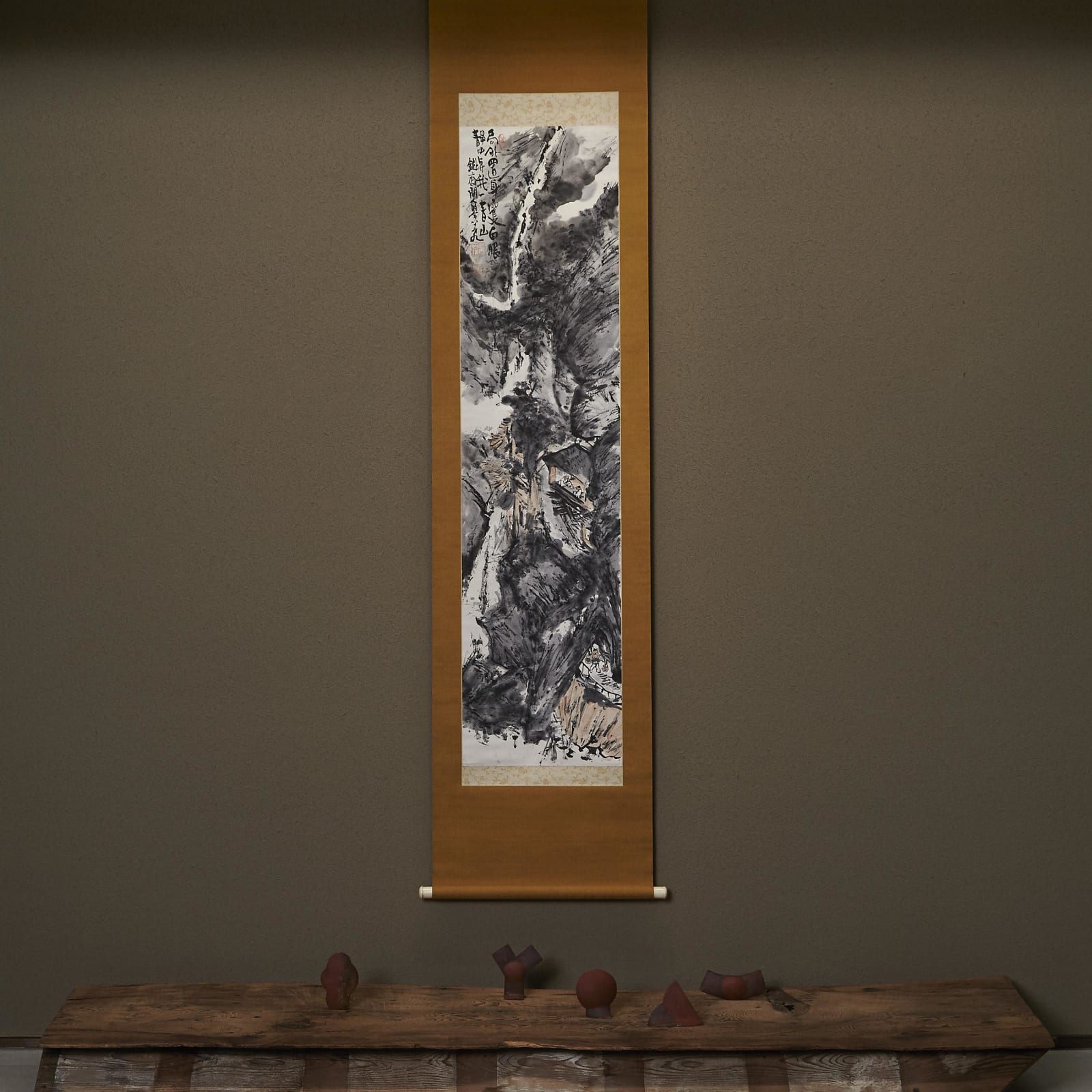Tomioka Tessai (1836–1924)
Dwelling among Mountains
Ink and light color on paper, hanging scroll
Inscription by the artist
At the age of 89
With a box signed by the artist (1924), double boxed
Seals: (Shoroku); Tomioka Hyakuren; Tetsudojin
133.5 x 33.2 cm
208 x 46 cm (overall)
Inscription by the artist
At the age of 89
With a box signed by the artist (1924), double boxed
Seals: (Shoroku); Tomioka Hyakuren; Tetsudojin
133.5 x 33.2 cm
208 x 46 cm (overall)
Further images
Painted in 1924, this is one of the last ink sansui paintings of Tomioka Tessai. The artist masterfully employs the interplay of junpitsu (brush fully dipped with ink) and sappitsu (half dried brush) in his energetic depiction of the mountain rocks. Two noble-minded gentlemen are engaged in conversation in a straw-thatched hut at the edge of the mountain rocks.
Tessai’s inscription reads: “Distanced from this mundane world, I look with the whites of my eyes when encountering worldly matters. Within the complete silence, there are only me and the green mountains.” The “whites of eyes” expression is an allusion to the saying of Ruan Ji, one of ancient China’s Seven Sages of the Bamboo Grove, who retreated from the public life and greeted worldly men with the whites of his eyes and friends with “blue eyes” (welcoming attitude). This allusion is also found in the poems of Wang Wei, the Tang dynasty poet regarded as the ancestor of literati.
On the storage box, Tessai wrote: “Since July of 1924, it had not rained. Finally it rained in late August. Everyone is thrilled at this, and I am also excited and paint this work.” Through this inscription, the artist’s exhilaration of the natural blessing and with it the human joyous reveals a master’s matured mind.
Tomioka Tessai (literati painter; 1836–1924)
Also known as Tetsujin; Tesshi; etc.
Kyoto-born literati painter. His real names are Yusuke and Hyakuren. Educated in Classical Japanese literature, Chinese studies and poetry. Became a working student of the waka poet Otagaki Rengetsu, who gave considerable influence upon Tessai’s personality. Closed to the Bakumatsu revolutionists, and active in the political field during this period. Appointed the chief priest of Isonokami-jingu shrine in Yamato and otori-jinja shrine in Izumi. Resigned and became a recluse later. Co-founded Nihon nanga kyokai with Tanomura Chokunyu, Taniguchi Aizan and others. Pursued a free artistic career as a scholar. His knowledge and painting technique made him an important figure of the literati in the modern times. Designated as an Imperial Court Artist and a member of Teikoku Bijutsuin (Imperial Fine Art Academy).
Tessai’s inscription reads: “Distanced from this mundane world, I look with the whites of my eyes when encountering worldly matters. Within the complete silence, there are only me and the green mountains.” The “whites of eyes” expression is an allusion to the saying of Ruan Ji, one of ancient China’s Seven Sages of the Bamboo Grove, who retreated from the public life and greeted worldly men with the whites of his eyes and friends with “blue eyes” (welcoming attitude). This allusion is also found in the poems of Wang Wei, the Tang dynasty poet regarded as the ancestor of literati.
On the storage box, Tessai wrote: “Since July of 1924, it had not rained. Finally it rained in late August. Everyone is thrilled at this, and I am also excited and paint this work.” Through this inscription, the artist’s exhilaration of the natural blessing and with it the human joyous reveals a master’s matured mind.
Tomioka Tessai (literati painter; 1836–1924)
Also known as Tetsujin; Tesshi; etc.
Kyoto-born literati painter. His real names are Yusuke and Hyakuren. Educated in Classical Japanese literature, Chinese studies and poetry. Became a working student of the waka poet Otagaki Rengetsu, who gave considerable influence upon Tessai’s personality. Closed to the Bakumatsu revolutionists, and active in the political field during this period. Appointed the chief priest of Isonokami-jingu shrine in Yamato and otori-jinja shrine in Izumi. Resigned and became a recluse later. Co-founded Nihon nanga kyokai with Tanomura Chokunyu, Taniguchi Aizan and others. Pursued a free artistic career as a scholar. His knowledge and painting technique made him an important figure of the literati in the modern times. Designated as an Imperial Court Artist and a member of Teikoku Bijutsuin (Imperial Fine Art Academy).













